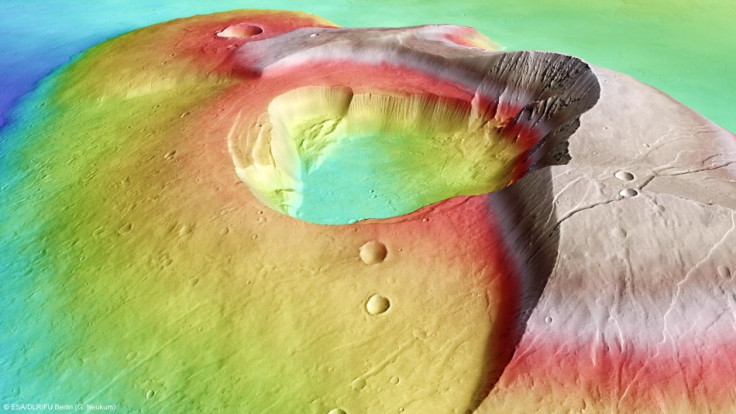Mars mega volcanoes: Tharsis dome spewed so much lava it shifted Red Planet's surface

Massive volcanic eruptions on Mars produced so much lava it moved the whole surface of the planet, with the north and south poles being shifted to different positions, researchers have said. Scientists say eruptions at Tharsis – home to the largest volcanoes in the Solar System – 3.5 billion years ago, caused huge geological changes to the Red Planet, altering the planet's geological history.
Researchers from Universite Paris-Sud were looking at the formation of the Tharsis dome, a massive geological feature of Mars that weighs around a billion billion tonnes or 1/70<sup>th of the moon. Previously, researchers believed it had formed by the end of the Noachian period (about 4.1 to 3.7 billion years ago) and had played a role in the orientation of rivers on the planet.
However, a study published in the journal Nature now suggests this is not the case, with Tharsis forming at a later date, and having a huge impact on the planet. Previous theoretical research had shown if the Tharsis dome was removed, the planet would shift on its axis. Using this finding, along with observations of geological features, researchers were able to carry out computer simulations to reconstruct to topography of Mars over time – both before the formation of Tharsis and after.

They found eruptions began about 3.7 billion years ago and lasted for around two million years. During this time, the weight of the lava produced would have caused Mars's two uppermost layers − the crust and the mantle − to swivel around by between 20 and 25 degrees. Had this happened on Earth, it would be like Paris being pushed up to the polar circle.
And the results fit in with the unusual positioning of river beds and underground reservoirs. Their findings showed the directions of valley networks do not require the presence of Tharsis. When the shift of the planet's surface is taken into account, the networks line up. Furthermore, the results help explain why Tharsis sits on the equator, as this would have been necessary for the planet to regain an equilibrium.
In terms of implications, the team says the growth and Tharsis and the creation of the valleys could provide a link between volcanic outgassing and the stability of liquid water on the surface of Mars. Under their proposed scenario, the period of stable water may have been caused by the volcanic activity, and could provide an avenue through which to look for signs of life.
Study author Sylvain Bouley told AFP: "There are still a lot of unanswered questions. Did the tilt cause the magnetic fields to shut down? Did it contribute to the disappearance of Mars's atmosphere, or cause the rivers to stop flowing? These are things we don't know yet."
© Copyright IBTimes 2025. All rights reserved.






















